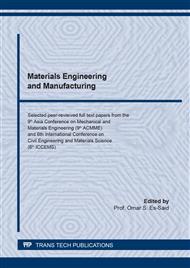[1]
Information on https://www.who.int/news-room/q-a-detail/radiation-ultraviolet-(uv).
Google Scholar
[2]
J. L. S. Acosta, F. M. Santoyo, J. M. F. Moreno, M. S. H. Montes, M. H. T. Ibarra, G. Frausto, S M. Silvino, E. E. L. Hernández: Opt. Lasers Eng. Vol. 137 (2020), p.106345.
Google Scholar
[3]
N. Serpone, A. Salinaro, S. Horikoshi, H. Hidaka: J. Photochem. Photobiol., A Vol. 179 (2006) p.200.
Google Scholar
[4]
L. H. F. Mullenders: Photochem. Photobiol. Sci. Vol. 17(12) (2018), p.1842.
Google Scholar
[5]
M. Ichihashi, M. Ueda, A. Budiyanto, T. Bito, M. Oka, M. Fukunaga, K. Tsuru, T. Horikawa. Toxicology Vol. 189 (2003), p.21.
DOI: 10.1016/s0300-483x(03)00150-1
Google Scholar
[6]
C. M.-Edinger: 9 Focus Technology – Sunscreens, Handbook of UV Degradation and Stabilization (Third Edition) (2020).
Google Scholar
[7]
J. J. Reinosa, C. M. Á. Docio, V. Z. Ramírez, J. Francisco, F. L. Hierarchical: Ceramics Int. Vol. 44 (2018), p.2827.
Google Scholar
[8]
S. S. Fouad, B. Parditka, M. Nabil, E. Baradács, S. Negm, H. E. Atyia, Z. Erdélyi: Optik Vol. 233 (2021), p.166617.
DOI: 10.1016/j.ijleo.2021.166617
Google Scholar
[9]
J. Fang, A. Shijirbaatar, D. Lin, D. Wang, B. Shen, P. Sun, Z. Zhou: Chemosphere Vol. 184 (2017), p.1125.
Google Scholar
[10]
H. K. Singh, S. Kumar, J. Bamne, K. Taiwade, N. Singh, V. Chandel, F. Z. Haque: Mater. Today (2020), in press.
Google Scholar
[11]
E.M. Balboa, M.L. Soto, D.R. Nogueira, N. González-López, E. Conde, A. Moure, M.P., Vinardell, M. Mitjans, H. Domínguez: Ind. Crops Prod. Vol. 58, (2014), p.104.
DOI: 10.1016/j.indcrop.2014.03.041
Google Scholar
[12]
L. López-Hortasa , E. Condeb , E. Falquéc , H. Domíngueza , M.D. Torres: Industrial Crops & Products Vol. 145 (2020), p.112079.
Google Scholar
[13]
V. H. P. Infante, P. M. B. G. Mai, Campos, L.S. Calixto, M. E. Darvin, M. Kröger, S. Schanzer, S.B. Lohan, J. Lademann, M. C. Meinke: Inter. J. Pharma. Vol. 598 (2021), p.120262.
DOI: 10.1016/j.ijpharm.2021.120262
Google Scholar
[14]
R. C. Romanhole, A. L. M. Fava, L. L. Tundisi, L. M. deMacedo, É. M. Santos, J. A. Ataide, P. G. Mazzola: Inter. J. Pharma. Vol. 591 (2020), p.120013.
DOI: 10.1016/j.ijpharm.2020.120013
Google Scholar
[15]
C. Berkey, N. Oguchi, K. Miyazawa, R. Dauskardt: Biochem. Biophys. Rep. Vol. 19 (2019), p.1006573.
Google Scholar
[16]
C.-Y. Ho, J. K. Lin, H.-W. Wang: Inter. J. Photoenerg. (2015), p.1.
Google Scholar
[17]
G. Gohari, A. Mohammadi, A. Akbari, S. Panahirad, M. R. Dadpour, V. Fotopoulos, S. Kimura: Sci. Rep. Vol. 10 (2020), p.912.
Google Scholar
[18]
K. K. Taha, M.A. Zoman, M.A. Outeibi, S. Alhussain, A.M. Abdulaziz, A. Bagabas: Nanotech. Environ. Eng. (2019), p.4.
Google Scholar
[19]
A. Dhanalakshmi, B. Natarajan, V. Ramadas, A. Palanimurugan, S. Thanikaikarasan: Pramana–J. Phys. Vol. 87:57 (2016), p.1.
DOI: 10.1007/s12043-016-1248-0
Google Scholar
[20]
L. Zhang, Y. Jiang, Y. Ding, N. Daskalakis, L. Jeuken, M. Povey, A. J. O'Neill, David W. York, J. Nanopart. Res. Vol. 12 (2010), p.1625.
Google Scholar
[21]
L. Zhang, Y. Ding, M. Povey, D. York: Prog. Nat. Sci. Vol. 18 (2008), p.939.
Google Scholar
[22]
X. Lu, X. Lv, Z. Sun, Y. Zheng: Eur. Polym. J. Vol. 44 (2008), p.2476.
Google Scholar
[23]
P. Praveen, G. Viruthagiri, S. Mugundan, N. Shanmugam: Spectrochim. Acta, Part A Vol. 117 (2014), p.622.
Google Scholar
[24]
A. Taufq, H. N. Ulya, U. J Sunaryono, N. Hidayat, H. Susanto, N. M. Munasir, S. Soontaranon: IOP Conf. Series: J. Physics: Conf. Series Vol. 1093 (2018), p.012001.
DOI: 10.1088/1742-6596/1093/1/012001
Google Scholar
[25]
S. W. Balogun, O. O. James, Y. K. Sanusi, O. H. Olayinka: SN Appl. Sci. Vol. 2 (2020), p.504.
Google Scholar
[26]
T. Gutul1, E. Rusu, N. Condur, V. Ursaki, E. Goncearenco, P. Vlazan: Beilstein J. Nanotechnol. Vol. 5 (2014), p.402.
DOI: 10.3762/bjnano.5.47
Google Scholar
[27]
R. Y. Hong, J. H. Li, L. L. Chen, D. Q. Liu, H. Z. Li, Y. Zheng, J. Ding, Powder Technology Vol. 189 (2009), p.426.
Google Scholar


